The electoral system of Australia comprises the laws and processes used for the election of members of the Australian Parliament and is governed primarily by the Commonwealth Electoral Act 1918. The system presently has a number of distinctive features including compulsory enrolment; compulsory voting; majority-preferential instant-runoff voting in single-member seats to elect the lower house, the House of Representatives; and the use of the single transferable vote proportional representation system to elect the upper house, the Senate.
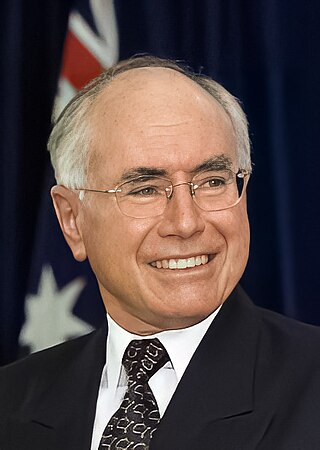
The 2001 Australian federal election was held in Australia on 10 November 2001. All 150 seats in the House of Representatives and 40 seats in the 76-member Senate were up for election. The incumbent Liberal Party of Australia led by Prime Minister of Australia John Howard and coalition partner the National Party of Australia led by John Anderson defeated the opposition Australian Labor Party led by Kim Beazley. As of 2024, this was the most recent election to feature a rematch of both major party leaders. Future Opposition Leader Peter Dutton entered parliament at this election.
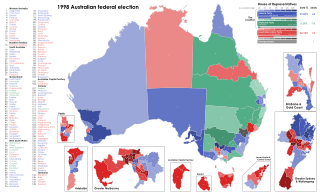
The 1998 Australian federal election was held to determine the members of the 39th Parliament of Australia. It was held on 3 October 1998. All 148 seats of the House of Representatives and 40 seats of the 76 seat Senate were up for election. The incumbent centre-right Liberal/National Coalition government led by Prime Minister John Howard of the Liberal Party and coalition partner Tim Fischer of the National Party defeated the centre-left Australian Labor Party opposition led by Opposition Leader Kim Beazley, despite losing the nationwide popular and two-party preferred vote. However, the Australian Labor Party gained seats compared to the previous election.

The 2004 Australian federal election was held in Australia on 9 October 2004. All 150 seats in the House of Representatives and 40 seats in the 76-member Senate were up for election. The incumbent Liberal Party of Australia led by Prime Minister of Australia John Howard and coalition partner the National Party of Australia led by John Anderson defeated the opposition Australian Labor Party led by Mark Latham.
The Australian People's Party was a registered political party in Australia. It was registered by the Australian Electoral Commission in March 2017. It was formed in 2014. The party recruited enough members to gain registration in March 2017. The party said its aim was to improve standards of living and rights for all Australians through commonsense policies. The party describes itself as a centrist party. The party was de-registered in November 2021 by the Australian Electoral Commission for not having 500 members.

The 1987 Australian federal election was held in Australia on 11 July 1987, following the granting of a double dissolution on 5 June by the Governor-General Sir Ninian Stephen. Consequently, all 148 seats in the House of Representatives as well as all 76 seats in the Senate were up for election. The incumbent Australian Labor Party, led by Prime Minister Bob Hawke, defeated the opposition Liberal Party of Australia, led by John Howard and the National Party of Australia led by Ian Sinclair. This was the first, and to date only, time the Labor Party won a third consecutive election.
The 1918 Swan by-election was a by-election for the Division of Swan in the Australian House of Representatives, following the death of the sitting member Sir John Forrest. Held on 26 October 1918, the by-election led to the election of the youngest person to be elected until 2010 to the Parliament of Australia, Edwin Corboy. It saw the conservative vote split between the Country Party and the Nationalist Party, which directly prompted the introduction of preferential voting in Australia.
John Gordon "Jack" Evans was an Australian businessman and politician who served as an Australian Democrats senator for Western Australia from 1983 to June 1985.
The Centre Party, previously the Country Party, was a minor Australian political party in the state of Tasmania. Initially formed in 1962 as a new Tasmanian branch of the Country Party of Australia after decades of inactivity in the state, it at first enjoyed no electoral success. In the run up to the 1969 election the party was joined by Kevin Lyons, a former Liberal turned independent member of the Assembly for Braddon, who renamed it the Centre Party and retained his seat at the election, securing the balance of power and serving as Deputy Premier in a coalition government until 1972. Upon the coalition's collapse the Centre Party faded away before being dissolved in 1975.
This article provides information on candidates who stood for the 1987 Australian federal election. The election was held on 11 July 1987.
This is a list of electoral results for the Division of Gwydir in Australian federal elections from the division's creation in 1901 until its abolition in 2007.
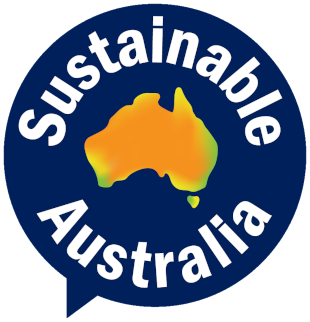
The Sustainable Australia Party (SAP), officially registered as Sustainable Australia Party – Universal Basic Income, is an Australian political party that was formed in 2010.

The United Australia Party (UAP), formerly known as Clive Palmer's United Australia Party and the Palmer United Party (PUP), is an Australian political party formed by mining magnate Clive Palmer in April 2013. The party was deregistered by the Australian Electoral Commission in 2017, revived and re-registered in 2018, and voluntarily deregistered in 2022. The party fielded candidates in all 150 House of Representatives seats at the 2013 federal election. Palmer, the party's leader, was elected to the Division of Fairfax and it reached a peak of three senators following the rerun of the Western Australian senate election in 2014. When the party was revived under its original name in 2018, it was represented by ex-One Nation senator Brian Burston in the federal parliament.
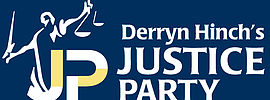
Derryn Hinch's Justice Party, also known as the Justice Party, was a political party in Australia, registered for federal elections since 14 April 2016. The party was named after its founder, Derryn Hinch, an Australian media personality.

The following tables show state-by-state results in the Australian Senate at the 1987 federal election. This election was a Double dissolution, which means that all 12 senators from each state were up for election. Senators total 29 coalition, 32 Labor, one Jo Vallentine Peace Group, four non-coalition National, seven Democrats, one Nuclear Disarmament and one Independent. Territory Senators served until the next federal election. State Senator terms were nominally three or six years, backdated from 1 July 1987. The Senate used the order-elected method to allocate three- and six-year seats, despite provisions for the AEC to conduct a special recount.
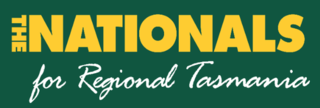
The Tasmanian Nationals are a political party in the Australian state of Tasmania, aligned with the National Party of Australia. The party is not currently registered with the Tasmanian Electoral Commission, and is not separately registered with the Australian Electoral Commission, unlike the other state branches of the Nationals.
This is a list of electoral results for the Australian Senate in Victoria since Federation in 1901.
This is a list of electoral results for the Australian Senate in Western Australia since Federation in 1901.
This is a list of electoral results for the Australian Senate in Tasmania since Federation in 1901.
This is a list of electoral results for the Australian Senate in Queensland since Federation in 1901.








